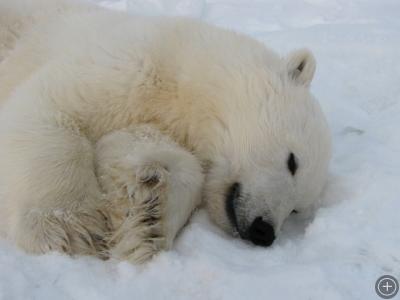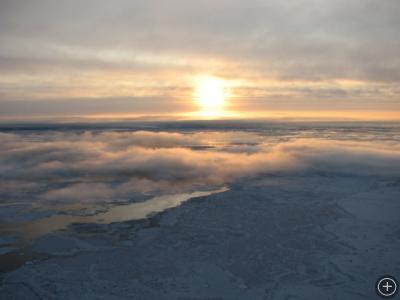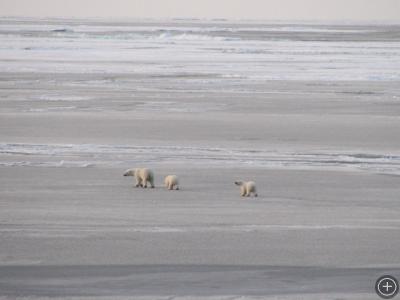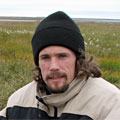Another Recapture, and Big Seas
ABOARD THE USCGC POLAR SEA, ON THE CHUKCHI SEA– Over the last week we kept the ship in the same general area, in the northern reaches of the Chukchi Sea. Several days of cooler weather allowed the ice to thicken a little, and we had another successful recapture of an adult female with her cub. These bears had less fat and were not in as good of condition as the previous recaptures, but overall they still appeared healthy.

We last saw this 10 month old cub, a male, and his mother on April 25th. All of the re-sampling for both bears went well.

Despite some patchy fog, we had calm winds and sunshine for most of the capture operations. Once we are out of view of the ship, the ice just stretches out to the horizon. This is about as high as the sun gets, even in the middle of the day. On this day the sun rose around 1030am and set around 715pm.
After the recapture we were able to download data from the collar and several of the data loggers, including travel path of the bear, activity patterns, and body temperature. After spending the spring off the coast near Prudhoe Bay, this female and her cub walked about two hundred miles (just an estimate – we will have to calculate this precisely later) northwest, then spent much of September in the northern Chukchi Sea. We get so much valuable information from just one bear that as soon as preliminary data on the travel path, activity, and temperature are downloaded, it is easy to put off other work and immediately begin exploring the data. It is very exciting to consider why the bears traveled as they did by matching up patterns in the different sets of information.
After the recapture of the female and her cub we began moving the ship slightly south for another bear. As we cruised a strong wind picked up out of the east, blowing across several hundred miles of open water and generating big swells before reaching our position at the edge of the pack ice. The ice became thinner and more inconsistent, and was broken into small pans maybe 5-10 meters across. The big swells were tamped slightly by the ice, but for the most part they rolled right on under the ice, heaving it up and down. Standing on the bow and watching the ice move was like watching an enormous tapestry waving in the wind.
By the time we neared the bear’s last position around dinner last night even the thin newly-forming ice had broken up and we were mostly traveling in open water. The wind was a steady 30 knots and the swells were 2-4 meters, occasionally up to 5 meters (these were swells about 6-12 feet, up to 15 feet!). The ship’s hull was designed for breaking ice, which sacrifices some stability in swells; as a result, we were really rolling. I had to keep a hand on a rail walking around the ship, especially going up and down ladders – twice I knocked my head against a hatch going up a ladder as the ship swayed yesterday. Two of our lab chairs are on wheels – if no one was sitting in them we had to tie them to the counter, otherwise they would roll across the lab and run into people. The waves were too large to allow the ship to drift for the night, nor was there good ice nearby in which to hove to for the night. We had to decide to keep the ship traveling in a large circle for the night, or to move on. Since there was almost no chance of finding our bear on ice safe enough for capture operations, we decided we would turn north again towards a different bear and hopefully away from the worst of the weather.
After dinner the announcement came on “Weather Decks now secure to all traffic”, meaning that no personnel were allowed outside because of the weather. I spent the evening on the bridge, watching the bow rise up and crash down through waves. The ship is 399 feet long and 89.5 feet wide at the widest. The rocking seemed to happen in slow motion. The nose would rise and the wave trough would suddenly fall away, followed by a moment of lightweightedness as the ship fell downwards before the next swell rose up, and then the descent would stop suddenly as the nose crashed back into the water and whitewater shot out in all directions. Several of the swells put whitewater just barely over the bow onto the front deck (the fos’cle). No one knew for sure, but it seemed we were pitching somewhere around 15 degrees, maybe higher. A couple folks on the bridge told stories of taking rolls around 50 degrees during really bad weather – that kind of roll is difficult to imagine.
It was difficult to sleep because of the rolling of the ship, but by late morning the weather had subsided. By afternoon today the swells had come down quite a bit, allowing us to begin taking a direct route to our next bear rather than trying to skirt the weather. We are now headed south, towards the pack ice that runs parallel to the Alaskan coast. We have a cluster of bears to recapture in that area and we hope to fly for the first of the group tomorrow.
Several nights ago as we were breaking thin ice a family group of polar bears was spotted. An announcement was made and the ship slowed, allowing personnel an opportunity to see the bears as we cruised past. It was an adult female and two cubs, both about 10 months old. It was interesting to see them – they may have come from Alaska or Russia, or even Greenland or Canada; they may go to land next summer, or they may spend their entire lives out here on the ice.
*I am not sure if anyone has left comments on recent posts, but if so, my apologies for not responding; I can email these dispatches to the Exploratorium but there is almost no internet connectivity on the ship and I cannot actually go online to see the website myself.











Love the pictures and so glad the sampling on the cubs went ok.Sounds like this trip you are getting alot of the research and samples that you need so that is a good thing,. I bet the rocking of the boat it would be hard to sleep with all of that going on to.
Good luck with your work
Thank you for telling this story. My friend is on the boat with you and is not as eloquent or discriptive a writer about the experience at sea and with the bears and the science on board, it helps friends and family at home to feel not so far away but more importantly brings home that feeling that were all in this together as far as the impact we have on climate change.
Thank you so much for the posting! Keep it up. We are listening.
Wow! My husband, George, is on the ship now. Haven’t heard from him since he’s been on the ship. From reading your blog, I think I am sea sick. Thanks for sharing your experience.
Love reading your stories of the trip. I agree with Louann, your descriptions are great. My son is on board, he’s one of the crewman on bearwatch. This is an experience of a lifetime that we the families get to live through the pictures and stories from the crew and those onboard. Thank you and keep writing.